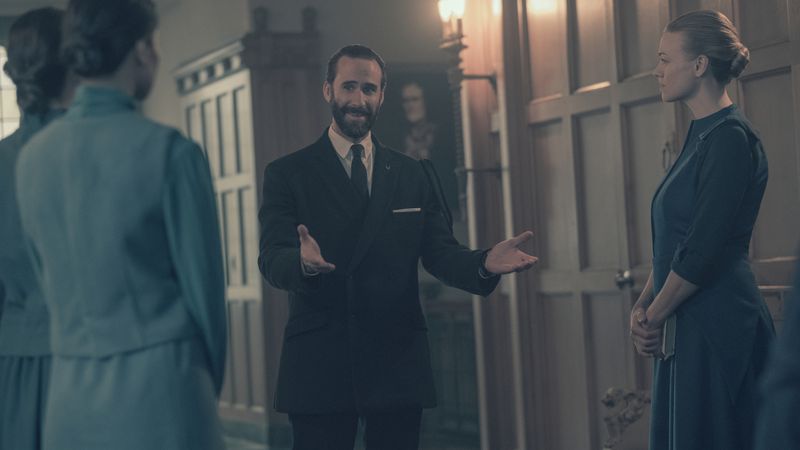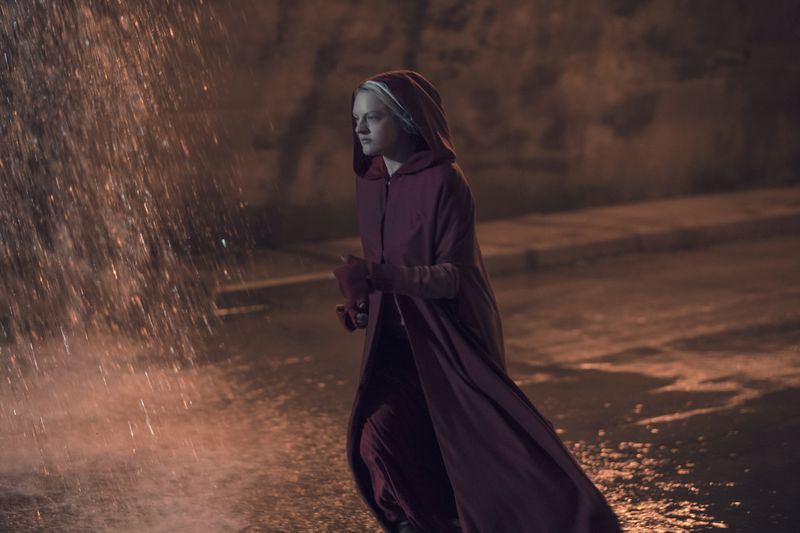The show finally embraced its horror series destiny — and kinda became The Walking Dead for progressives.
The second season of The Handmaid’s Tale was, in almost every way, a marked improvement on the first. It was bolder in its storytelling, more incisive with its character arcs, and knitted together with stronger thematic underpinnings.
Without Margaret Atwood’s book to fall back on, for the most part, the series pulled back just a bit (literally, in the case of the camera, which dropped more often into wide shots) to examine the ways totalitarian societies hollow from the inside out, taking and taking and taking, until they become the only way of life you know. It was as timely as season one, but in a very different way, less triumphal and certain of the power wielded by large groups of people raising their voices as one.
It was also so, so, so much harder to watch, in a way that maybe sort of broke the show.
This is the paradox of series like The Handmaid’s Tale. Sometimes, making your show better can simultaneously make it worse, can expose the flaws in the template that were always there that viewers were better able to overlook when there were more obvious and glaring flaws to point to.
Make no mistake: The second season of The Handmaid’s Tale will be very high up on my year-end “best of TV” list, and I feel it made only very minor mistakes. (Mistakes that, sadly, include the very last scene of the season, leaving a bad taste in the mouth.)
But I’m more worried than ever — and I was already pretty worried — that the series has no long-term plan beyond rubbing viewers’ noses in misery. And worse, even if it does have a plan to alleviate the sorrow, embarking on such a plan might be antithetical to the spirit of the show, breaking it even more.
In season two, The Handmaid’s Tale finally and firmly became a horror series
 Hulu
HuluThe first two seasons of The Handmaid’s Tale form a loose diptych, mirroring and subverting each other in fascinating ways. They’re about survival in the midst of dystopia, about the idea that those who are oppressed continue to find ways to live and hope, even when doing so seems pointless. My guess — more of my hope, really — is that by the end of the show’s run, we will realize this was a “first chapter,” of sorts, as the show pivots to a new chapter about how unsustainable the theocratic hellscape of Gilead is.
But the first season kept stepping back to remind viewers, “Hey, this is a TV show.” Pop songs would turn up on the soundtrack with weird regularity. Handmaids would stride toward the camera in formation, in ways that seemed designed to underline their force as a potential army against their oppressors. It was laced through with hope and triumphalism, with a sense that the series was always about five seconds away from having star Elisabeth Moss flex her bicep in a Rosie the Riveter pose.
This stuff was easy to point to as a problem with the series. After all, the world the Handmaids live in is one that offers little hope or triumph for them. They’re held as rape slaves by a theocratic patriarchy, and even if they theoretically outnumber their oppressors, they’re systemically kept down by a government that believes them to be little more than chattel.
But the more season two wore on, the more it stripped away the hope and the triumphalism, the more I realized that these flaws were part of why the show was able to break out in its first season. It’s similar to the way that Mad Men’s first season was riddled with lots of ridiculous reminders of how different the ’60s were, which critics could point to as flaws, but viewers could welcome as punctures in the show’s immersive nature.
It’s really easy to get lost in Handmaid’s Tale, which is sumptuously designed and filmed at every level. It all but invites you into its space, through those frequent, eerie close-ups, shot with wide-angle lenses to blur out the backgrounds. Hearing pop music deployed as a clumsy metaphor for not losing hope is a great way to break the spell, to lure the viewer back to reality, where things are not this bad. Not yet.
And in season one, early in the Donald Trump administration, it was easy for progressives watching The Handmaid’s Tale to believe that hope and triumphalism could exist side by side with worry and sadness. In season two, that was harder to believe, as it became clear that the actions of Trump, even if he is booted from office before 2025, even if he’s booted from office tomorrow, won’t take years or even decades to overturn, but likely generations. The few times hope punctured the Handmaid’s Tale bubble — one time featuring Oprah Winfrey herself — felt more like dispatches from another universe than ever before.
And The Handmaid’s Tale kept accidentally releasing episodes that directly seemed to comment on what the administration had done just that week, including an episode about Gilead’s squabbles with Canada (in the wake of Trump’s lambasting of Canadian leader Justin Trudeau) and then another in which June’s daughter, Hannah, is ripped from her arms, which aired almost directly in the midst of the family separation crisis at the US’s southern border.
None of this is the show’s fault, of course, nor is the frequently clumsy marketing surrounding products meant to tie into it. But they all increase the noise around the show, which can make it harder to see the series for whatever it still is. (This, again, is reminiscent of what happened to Mad Men.)
And what the show has become is, in essence, a horror series. All of the hope in season one has been ground out of the show. Its shift from close-ups to wide shots in many episodes underlines the ways all of these characters are at once trapped by Gilead and a part of it, unable to escape their own complicity.
The show weaponizes what we know to be true about television — there will always be a status quo for the characters to return to, most regular characters have “plot armor” that keeps them safe — and it uses it to remind us, over and over again, that if you had to live through these truths, unable to change or evolve, it would be an unending horror.
And in that sense, perhaps, it has become a kind of progressive Walking Dead. That show crystallized conservative fears about America under Obama by depicting small communities of stalwart traditionalists being beset by hordes of outsiders.
But where The Walking Dead could always fall back on metaphor — I might be a progressive, but I love zombie movies and can enjoy them purely on the level of genre — The Handmaid’s Tale can’t. It keeps trying to make Gilead a metaphor for reality in a way that would crystallize progressives’ fears about Trump while allowing just enough remove to keep watching. But reality keeps refusing to be made metaphorical.
The Handmaid’s Tale is probably going to have to become a very different show to survive. But that, too, could be a fruitless endeavor.
 Hulu
HuluThe final moments of season two of The Handmaid’s Tale don’t seem to radically shift the series’ status quo. Indeed, they seem to underline just how hard it will be for the series to run indefinitely with that status quo in place. Sooner, rather than later, and maybe even right now, that status quo will become untenable.
But the more I thought about those final moments, the more I came to realize that they really do change the show’s status quo considerably, should the series follow through on it. Up until those final moments, the resistance to Gilead within the series was mostly whispered about and in the extreme background of the story. At the end of season two, it steps out into the light, in a way that suggests this is where the story will pivot going forward. June will find a way to take up arms against Gilead, will become a revolutionary, a resistance fighter, maybe even a “terrorist.”
But this, too, might be against the spirit of the show.
To be clear, I’m not precious about the Atwood novel. I think it is a remarkable feat of literature, but an ongoing series adaptation of it is inevitably going to have to widen the scope of what is, ultimately, a very claustrophobic book. It’s going to have to world-build and add character arcs and introduce its own new characters who can stand alongside those from the novel. (The lattermost of these is something the series still struggles with.) And even in the book, it’s clear that Gilead eventually falls, though it happens way off-page.
What strikes me as a “problem,” however, is the idea that June herself might be instrumental to the collapse of Gilead. It’s not against the novel, which ends June’s story on one of literature’s most famous cliffhangers, since there, the future of Offred (we don’t know her pre-Gilead name in the book) is so unknown to us. For all we know, she started making homemade Molotov cocktails and burning down whole cities.
But Offred/June is a character defined by her normalcy and by how horrifying her “normal life” has become, by the idea that in some other life, she might have lived a “Tale” of long, rainy Sundays and seeing her daughter off to college and finally a hard-earned retirement.
Making that woman into a revolutionary hero feels like a difficult leap. And every time I’ve talked to someone who works on the series’ writing staff, they’ve referred to June as a “hero,” not in the sense of her being the protagonist (and, thus, “our hero”) but often in the sense of her building toward some great destiny.
That said, it’s basically what the TV show has to do to survive at this point. (Though add me to the chorus of TV critics calling for the show to set a hard and fast end date in season four or five.) As much as I find the twisted dynamics within the show’s central settings intriguing (especially when they involve the remarkable Yvonne Strahovski slowly awakening to the oppression she submitted to live under), making the series stumble through them for many more seasons would exhaust it and tarnish its legacy.
Sending June into the midst of the resistance could work as a way to find new stories to tell within this world, and could also find a way to re-inject a sense of the hope that season two abolished back into the storytelling.
But that would, in the end, cut against what made season two so remarkable and so hard to watch. Those wide shots took The Handmaid’s Tale away from just one woman’s story and turned it into a country’s story, into a tale of what happens when you become complicit in monstrosity by accidents of history. I’d say that story is timely, but it always is. The show’s trick will be seeing if it can find a way to make a story of burning that system to the ground just as vital. Stories of struggle, of unending doom are easy to tell on television. Stories of release are much, much harder.
The Handmaid’s Tale is available on Hulu.
Read More
https://cdn.vox-cdn.com/community_logos/52517/voxv.png



